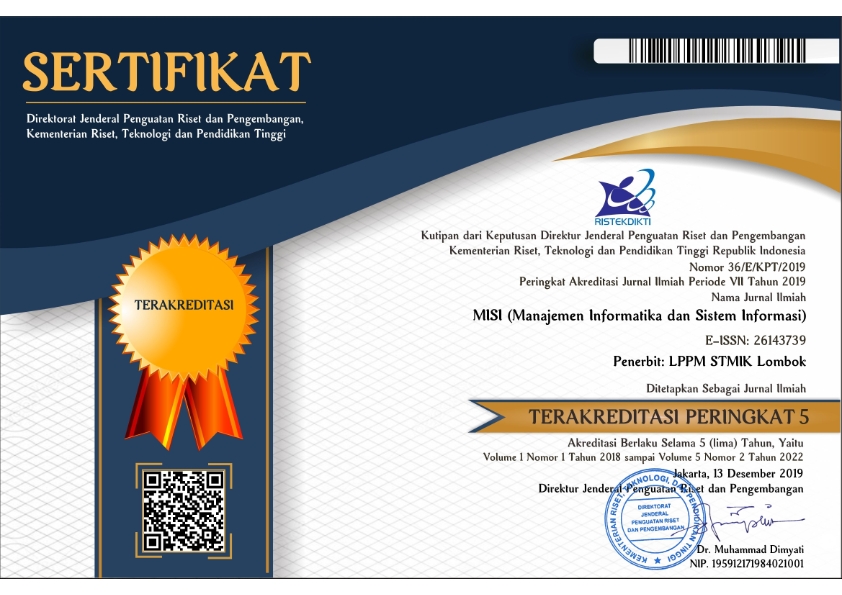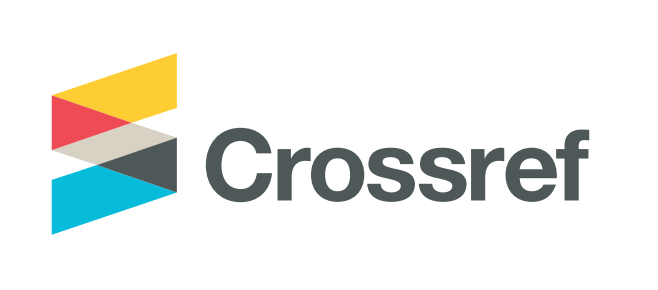ANALISIS PREDIKSI RADIASI MATAHARI DENGAN ALGORITMA MACHINE LEARNING DAN IMPLEMENTASI BAYESIAN OPTIMIZATION DI PROVINSI DKI JAKARTA
DOI:
https://doi.org/10.36595/misi.v8i1.1338Keywords:
Radiasi matahari harian, prediksi radiasi matahari, SVR, XGboost, multivariate time seriesAbstract
Peningkatan populasi menyebabkan peningkatan permintaan energi. Hingga saat ini, masalah terkait energi adalah sumber daya yang terbatas. Energi alternatif terbarukan dapat dimanfaatkan secara optimal di masa depan. Salah satu sumber energi terbarukan adalah energi matahari karena jumlahnya melebihi kebutuhan energi saat ini dan masa depan. Hal ini sejalan dengan target 7.2 dalam Sustainable Development Goals (SDGs) 2030, yaitu meningkatkan porsi energi terbarukan secara signifikan dalam bauran energi global. Indonesia memiliki potensi energi matahari melalui radiasi matahari. Namun, pemanfaatan potensi energi surya sebagai pembangkit listrik di Provinsi DKI Jakarta belum optimal. Penelitian ini bertujuan untuk memprediksi nilai radiasi matahari melalui Global Horizontal Irradiance (GHI) harian di DKI Jakarta menggunakan Support Vector Regression (SVR) dengan Bayesian Optimization dan membandingkannya dengan XGBoost untuk menemukan model terbaik dari hasil prediksi. Metode BO-SVR terbukti memberikan hasil prediksi yang baik dan kuat pada data yang digunakan karena MAPE dan RMSE untuk data pengujian masing-masing adalah 0,182 dan 34,412. Penerapan Bayesian Optimization dalam menentukan hiperparameter optimal dalam membentuk model prediksi telah terbukti meningkatkan kinerja model. Penelitian ini menghasilkan prediksi radiasi matahari yang memberikan informasi bagi pemerintah, khususnya PT Perusahaan Listrik Negara (PLN) dan peneliti terkait karakteristik radiasi matahari.
Downloads
References
M. Azhar and D. A. Satriawan, “Implementasi Kebijakan Energi Baru dan Energi Terbarukan Dalam Rangka Ketahanan Energi Nasional,” Administrative Law and Governance Journal, vol. 1, no. 4, pp. 398–412, 2018, doi: 10.14710/alj.v1i4.398-412.
SKK Migas, “Laporan Tahunan SKK Migas,” Jakarta, 2022.
A. Saputra, R. Lapisa, R. Refdinal, and S. Rizki Putri Primandari, “Analysis of the Effect of a Glass Layer on the Roof of a House of a Thermoelectric Generator on Temperature and Electrical Voltage,” MOTIVECTION?: Journal of Mechanical, Electrical and Industrial Engineering, vol. 4, no. 2, pp. 87–98, May 2022, doi: 10.46574/motivection.v4i2.115.
H. Ambarita, “Development of software for estimating clear sky solar radiation in Indonesia,” in Journal of Physics: Conference Series, Institute of Physics Publishing, Mar. 2017. doi: 10.1088/1742-6596/801/1/012093.
K. Obaideen et al., “Solar Energy: Applications, Trends Analysis, Bibliometric Analysis and Research Contribution to Sustainable Development Goals (SDGs),” Jan. 01, 2023, Multidisciplinary Digital Publishing Institute (MDPI). doi: 10.3390/su15021418.
G. N. Okonkwo and Nwokoye A.O.C, “Estimating Global Solar Radiation from Temperature Data in Minna Location,” 2014. doi: 10.19044/ESJ.2014.V10N15P.
L. Wang, O. Kisi, M. Zounemat-Kermani, G. A. Salazar, Z. Zhu, and W. Gong, “Solar radiation prediction using different techniques: Model evaluation and comparison,” Aug. 01, 2016, Elsevier Ltd. doi: 10.1016/j.rser.2016.04.024.
Sekretariat Jenderal Dewan Energi Nasional, “Outlook Energi Indonesia 2023,” 2023.
Direktorat Jenderal Ketenagalistrikan Kementerian ESDM, Statistik Ketenagalistrikan, 36th ed. Jakarta, 2023.
Sekretariat KADIN Indonesia, “Tak Lagi Ibu Kota, Jakarta Akan Tetap Menjadi Pusat Ekonomi Nasional,” Kabar KADIN Daerah, Kabar KADIN Indonesia, Kabar Utama, Kadin Daerah, Kadin Indonesia. Accessed: May 30, 2024. [Online]. Available: https://kadin.id/kabar/tak-lagi-ibu-kota-jakarta-akan-tetap-menjadi-pusat-ekonomi-nasional/
N. Yanti et al., “Prediksi Radiasi Matahari Dengan Penerapan Metode Elman Recurrent Neural Network,” 2019.
I. El Naqa and M. J. Murphy, “What Is Machine Learning?,” in Machine Learning in Radiation Oncology, Cham: Springer International Publishing, 2015, pp. 3–11. doi: 10.1007/978-3-319-18305-3_1.
D. Sepri, A. Fauzi, R. Wandira, O. S. Riza, and Y. F. Wahyuni, “Prediksi Harga Cabai Merah Menggunakan Support Vector Regression,” Computer Based Information System Journal, vol. 8, no. 2, pp. 1–5, 2020, [Online]. Available: http://ejournal.upbatam.ac.id/index.php/cbishttp://ejournal.upbatam.ac.id/index.php/cbis
K. Mohammadi, S. Shamshirband, M. H. Anisi, K. Amjad Alam, and D. Petkovi?, “Support vector regression based prediction of global solar radiation on a horizontal surface,” Energy Convers Manag, vol. 91, pp. 433–441, 2015, doi: 10.1016/j.enconman.2014.12.015.
R. Urraca, J. Antonanzas, F. Antonanzas-Torres, and F. J. Martinez-De-pison, “Estimation of daily global horizontal irradiation using extreme gradient boosting machines,” Advances in Intelligent Systems and Computing, vol. 527, pp. 105–113, 2017, doi: 10.1007/978-3-319-47364-211.
P. Kumari and D. Toshniwal, “Extreme gradient boosting and deep neural network based ensemble learning approach to forecast hourly solar irradiance,” J Clean Prod, vol. 279, p. 123285, 2021, doi: 10.1016/j.jclepro.2020.123285.
C. Zhang, Y. Zhang, J. Pu, Z. Liu, Z. Wang, and L. Wang, “An hourly solar radiation prediction model using eXtreme gradient boosting algorithm with the effect of fog-haze,” Energy and Built Environment, 2023, doi: 10.1016/j.enbenv.2023.08.001.
Y. Zhou, Y. Liu, D. Wang, X. Liu, and Y. Wang, “A review on global solar radiation prediction with machine learning models in a comprehensive perspective,” May 01, 2021, Elsevier Ltd. doi: 10.1016/j.enconman.2021.113960.
Nasruddin, M. A. Budiyanto, and R. Nawara, “Comparative study of the monthly global solar radiation estimation data in Jakarta,” in IOP Conference Series: Earth and Environmental Science, Institute of Physics Publishing, Jan. 2018. doi: 10.1088/1755-1315/105/1/012111.
E. Yang, Q. Yang, J. Li, H. Zhang, H. Di, and Y. Qiu, “Establishment of icing prediction model of asphalt pavement based on support vector regression algorithm and Bayesian optimization,” Constr Build Mater, vol. 351, p. 128955, Oct. 2022, doi: 10.1016/j.conbuildmat.2022.128955.
S. Lahmiri, C. Tadj, C. Gargour, and S. Bekiros, “Optimal tuning of support vector machines and k-NN algorithm by using Bayesian optimization for newborn cry signal diagnosis based on audio signal processing features,” Chaos Solitons Fractals, vol. 167, p. 112972, Feb. 2023, doi: 10.1016/j.chaos.2022.112972.
J. de Andrade Silva and E. R. Hruschka, “EACImpute: An Evolutionary Algorithm for Clustering-Based Imputation,” in 2009 Ninth International Conference on Intelligent Systems Design and Applications, IEEE, 2009, pp. 1400–1406. doi: 10.1109/ISDA.2009.86.
C. Bishop, “Pattern Recognition and Machine Learning,” in Journal of Electronic Imaging, vol. 16, 2006, pp. 140–155. doi: 10.1117/1.2819119.
T. Kayikcioglu, M. Maleki, N. Manshouri, and T. Kay?kç?o?lu, “A Novel Simple Method to Select Optimal k in k-Nearest Neighbor Classifier,” 2017. [Online]. Available: https://sites.google.com/site/ijcsis/
H. Ahn, K. Sun, and K. Pio Kim, “Comparison of Missing Data Imputation Methods in Time Series Forecasting,” Computers, Materials & Continua, vol. 70, no. 1, pp. 767–779, 2022, doi: 10.32604/cmc.2022.019369.
P. I. Frazier, “A Tutorial on Bayesian Optimization,” Jul. 2018, [Online]. Available: http://arxiv.org/abs/1807.02811
R. Herrera Casanova and A. Conde, “Enhancement of LSTM models based on data pre-processing and optimization of Bayesian hyperparameters for day-ahead photovoltaic generation prediction,” Computers and Electrical Engineering, vol. 116, May 2024, doi: 10.1016/j.compeleceng.2024.109162.
D. R. Jones, M. Schonlau, and W. J. Welch, “Efficient Global Optimization of Expensive Black-Box Functions,” Journal of Global Optimization, vol. 13, no. 4, pp. 455–492, 1998, doi: 10.1023/A:1008306431147.
A. Kumar, S. Patil, A. Kovacevic, and S. A. Ponnusami, “Performance prediction and Bayesian optimization of screw compressors using Gaussian Process Regression,” Eng Appl Artif Intell, vol. 133, p. 108270, Jul. 2024, doi: 10.1016/j.engappai.2024.108270.
D. Wang, C. Wang, J. Xiao, Z. Xiao, W. Chen, and V. Havyarimana, “Bayesian optimization of support vector machine for regression prediction of short-term traffic flow,” Intelligent Data Analysis, vol. 23, no. 2, pp. 481–497, Apr. 2019, doi: 10.3233/IDA-183832.
A. M. Elshewey, M. Y. Shams, N. El-Rashidy, A. M. Elhady, S. M. Shohieb, and Z. Tarek, “Bayesian Optimization with Support Vector Machine Model for Parkinson Disease Classification,” Sensors, vol. 23, no. 4, p. 2085, Feb. 2023, doi: 10.3390/s23042085.
C. Cortes, V. Vapnik, and L. Saitta, “Support-Vector Networks Editor,” Kluwer Academic Publishers, 1995.
T. Chen and C. Guestrin, “XGBoost: A Scalable Tree Boosting System,” Mar. 2016, doi: 10.1145/2939672.2939785.
J. D. Chee, “Pearson’s Product-Moment Correlation: Sample Analysis,” 2013. [Online]. Available: https://www.researchgate.net/publication/262011045
Kent State University, “SPSS Tutorials: Pearson Correlation,” University Libraries. Accessed: Jun. 13, 2024. [Online]. Available: https://libguides.library.kent.edu/SPSS/PearsonCorr
A. R. Subian, D. A. Mulkan, H. H. Ahmady, and F. Kartiasih, “Comparison Methods of Machine Learning and Deep Learning to Forecast The GDP of Indonesia,” Sist. J. Sist. Inf., vol. 13, no. 1, pp. 149–166, 2024, [Online]. Available: https://doi.org/10.32520/stmsi.v13i1.3445.
Y. N. Hilal, G. D. A. Nainggolan, S. H. Syahputri, and F. Kartiasih, “Comparison of ARIMA and LSTM Methods in Predicting Jakarta Sea Level,” J. Ilmu dan Teknol. Kelaut. Trop., vol. 16, no. 2, pp. 163–178, 2024, [Online]. Available: https://doi.org/10.29244/jitkt.v16i2.52818.
S. S. Nurhayati, A. F. Khasanah, D. A. Revanadilla, T. B. Herindra, and F. Kartiasih, “Predicting Global Warming in East Kalimantan Province Using SARIMAX and Neural Network,” JUSTIN (Jurnal Sist. dan Teknol. Informasi), vol. 12, no. 3, pp. 394–404, 2024, doi: 10.26418/justin.v12i3.74946. https://doi.org/10.25134/equi.v21i02.
A. A. G. R. B. D. Pemayun, M. Z. Azizi, N. A. Daulay, N. H. Apriliani, and F. Kartiasih, “Estimation of Java GRDP in Regency/City Level: Satellite Imagery and Machine Learning Approaches,” JURTEKSI (Jurnal Teknol. dan Sist. Informasi), vol. X, no. 2, pp. 379–386, 2024, [Online]. Available: http://dx.doi.org/10.33330/jurteksi.v10i2.2993.
M. I. Rizki, T. A. Taqiyyuddin, N. C. Salma, and N. Nisrina, “Peramalan Penutupan Harga Saham The Walt Disney Dengan Metode Permodelan SARIMA Dan ARCH-GARCH,” Jurnal Sains Matematika dan Statistika, vol. 7, no. 2, Sep. 2021, doi: 10.24014/jsms.v7i2.13175.
C. V. Hudiyanti, F. A. Bachtiar, and B. D. Setiawan, “Perbandingan Double Moving Average dan Double Exponential Smoothing untuk Peramalan Jumlah Kedatangan Wisatawan Mancanegara di Bandara Ngurah Rai,” Jurnal Pengembangan Teknologi Informasi dan Ilmu Komputer, vol. 3, no. 3, pp. 2667–2672, 2019.
H. Wang, Q. Liang, J. T. Hancock, and T. M. Khoshgoftaar, “Feature selection strategies: a comparative analysis of SHAP-value and importance-based methods,” J Big Data, vol. 11, no. 1, 2024, doi: 10.1186/s40537-024-00905-w.
S. Ben Jabeur, S. Mefteh-Wali, and J. L. Viviani, “Forecasting gold price with the XGBoost algorithm and SHAP interaction values,” Ann Oper Res, vol. 334, no. 1–3, pp. 679–699, 2024, doi: 10.1007/s10479-021-04187-w.
S. M. Lundberg, G. G. Erion, and S.-I. Lee, “Consistent Individualized Feature Attribution for Tree Ensembles,” no. 2, 2018.
N. F. Muzakki, A. Z. Putri, S. Maruli, and F. Kartiasih, “Forecasting the Air Quality Index by Utilizing Several Meteorological Factors Using the ARIMAX Method (Case Study: Central Jakarta City),” Jurnal JTIK (Jurnal Teknologi Informasi dan Komunikasi), vol. 8, no. 3, pp. 569–586, Apr. 2024, doi: 10.35870/jtik.v8i3.2012.
Celvine Adi Putra, Rianda Pratama, and Tata Sutabri, “Celvine Adi Putra, Rianda Pratama, & Tata Sutabri. (2023). Analisis Manfaat Machine Learning Pada Next-Generation Firewall Sophos XG 330 Dalam Mengatasi Serangan SQL Injection,” Jurnal Manajemen Informatika dan Sistem Informasi, vol. 6, no. 2, pp. 197–204, Jun. 2023, doi: 10.36595/misi.v6i2.886.
G. Putra, A. Brahmantha, E. Utami, and A. Yaqin, “Klasifikasi Genre Anime Berdasarkan Sinopsis Menggunakan Algoritma K-Nearest Neighbors,” Jurnal Manajemen Informatika dan Sistem Informasi, vol. 7, no. 1, pp. 15–24, 2024, doi: 10.36595/misi.v5i2.
Downloads
Additional Files
Published
How to Cite
Issue
Section
License
Semua tulisan pada jurnal ini menjadi tanggungjawab penuh penulis.













